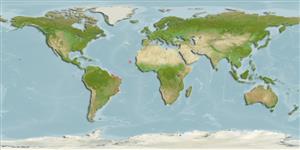>
Eupercaria/misc (Various families in series Eupercaria) >
Scaridae (Parrotfishes) > Sparisomatinae
Etymology: Sparisoma: Latin, sparus = a fish with a golden head + Greek, soma = body (Ref. 45335).
More on author: Steindachner.
Environment: milieu / climate zone / depth range / distribution range
экология
морской ассоциированный с рифами; пределы глубины 1 - 70 m (Ref. 40827). Tropical
Southwest Atlantic: endemic to Brazil and its oceanic islands.
Size / Вес / Возраст
Maturity: Lm ? range ? - ? cm
Max length : 43.6 cm SL самец/пол неопределен; (Ref. 111982)
Краткое описание
морфология | морфометрия
TP individuals readily separated from S. rubripinne by the presence of a distinctive bright-yellow area on the pectoral -fin axil, blackish caudal fin margins, yellowish dorsal and anal fins, and general body color which is grayish-white in S. axillare and blue-green in S. rubripinne. Initial phase individuals of S. axillare are brownish-gray with a yellow stain on the flanks and different from S. rubripinne by the absence of a bright- yellow area on the caudal peduncle and caudal fin. Head profile more rounded S. axillare (Ref. 40827).
Maximum depth from Ref. 126840. Occurs in oceanic islands, dwelling in coral, algal and rocky reefs and on algal beds (Ref. 40827). An herbivore (Ref. 33499), cleaned by Elacatinus figaro observed off the coast of São Paulo, southeastern Brazil (Ref. 40102) and by Pomacanthus paru observed at the reefs of the Abrolhos Archipelago, off eastern Brazil (Ref. 40094).
Life cycle and mating behavior
половая зрелость | размножение | нерест | икра | Fecundity | личинки
Moura, R.L., J.L. de Figueiredo and I. Sazima, 2001. A new parrotfish (Scaridae) from Brazil, and revalidation of Sparisoma amplum (Ranzani, 1842), Sparisoma frondosum (Agassiz, 1831), Sparisoma axillare (Steindachner, 1878) and Scarus trispinosus Valenciennes, 1840. Bull. Mar. Sci. 68(3):505-524. (Ref. 40827)
Статус Красного Списка МСОП (Ref. 130435)
Угроза для людей
Harmless
Использование человеком
дополнительная информация
народные названиясинонимыобмен веществхищникиэкотоксикологияразмножениеполовая зрелостьнерестSpawning aggregationFecundityикраРазвитие икры
ссылкиаквакультура (рыбоводство)особенности рыбоводствастепень растяжениягенетикаElectrophoresesнаследуемостьболезниобработкаNutrientsMass conversion
соавторыизображенияStamps, Coins Misc.звукиCiguateraскоростьтип плаванияжаберная областьOtolithsмозгзрение
инструменты
Специальные отчеты
Скачать в формате XML
ресурсы в Интернет
Estimates based on models
Preferred temperature (Ref.
123201): 23.6 - 27.6, mean 26.8 °C (based on 199 cells).
Phylogenetic diversity index (Ref.
82804): PD
50 = 0.5000 [Uniqueness, from 0.5 = low to 2.0 = high].
Bayesian length-weight: a=0.01288 (0.00813 - 0.02041), b=3.10 (2.97 - 3.23), in cm total length, based on LWR estimates for this species & Genus-body shape (Ref.
93245).
Trophic level (Ref.
69278): 2.0 ±0.1 se; based on size and trophs of closest relatives
устойчивость к внешним воздействиям (Ref.
120179): средний (среднего размера), минимальное время удвоения популяции 1.4-4.4 года (Preliminary K or Fecundity.).
Fishing Vulnerability (Ref.
59153): Moderate vulnerability (41 of 100).
Nutrients (Ref.
124155): Calcium = 44.3 [26.0, 82.7] mg/100g; Iron = 0.654 [0.359, 1.101] mg/100g; Protein = 18.3 [16.1, 20.7] %; Omega3 = 0.101 [0.060, 0.163] g/100g; Selenium = 33.3 [19.5, 61.8] μg/100g; VitaminA = 51 [16, 164] μg/100g; Zinc = 1.61 [1.12, 2.55] mg/100g (wet weight);
